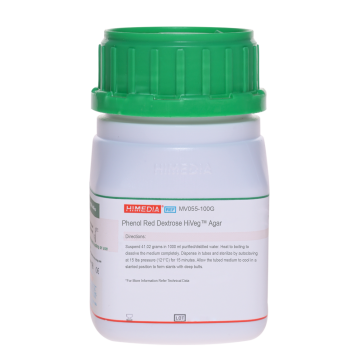 Your enquiry has been submitted
Your enquiry has been submitted
Phenol Red Dextrose Agar
Intended Use
Recommended for Dextrose fermentation studies of microorganisms.
Composition
| Ingredients | Gms / Litre |
|---|---|
| Proteose peptone | 10.000 |
| HM peptone B # | 1.000 |
| Sodium chloride | 5.000 |
| Dextrose (Glucose) | 10.000 |
| Phenol red | 0.025 |
| Agar | 15.000 |
Final pH (at 25°C): 7.4±0.2
**Formula adjusted, standardized to suit performance parameters
# Equivalent to Beef extract
Directions
Suspend 41.02 grams in 1000 ml purified / distilled water. Heat to boiling to dissolve the medium completely. Dispense in tubes and sterilize by autoclaving at 15 lbs pressure (121°C) for 15 minutes. Allow the tubed media to cool in slanted position to form slants with deep butts.
Principle And Interpretation
Phenol Red Agar media are recommended (1, 2, 5) for studying the fermentation of various carbohydrates individually by the pure cultures of microorganisms.
Proteose peptone and HM Peptone B which is free from fermentable carbohydrates is added in the medium thereby preventing the production of false positive reactions. When Phenol Red Agar with Dextrose is used, a positive carbohydrate fermentation reaction is indicated by the production of a yellow colour in agar due to the effect of acid production. Gas production is indicated by the splitting of agar or by the bubbles formation. Plates or tubes may be incubated aerobically or anaerobically depending on the type of the test organism.
Type of specimen
Isolated Microorganisms
Specimen Collection and Handling
For Isolated Microorganisms samples follow appropriate techniques for handling specimens as per established guidelines.
After use, contaminated materials must be sterilized by autoclaving before discarding.
Warning and Precautions
Read the label before opening the container. Wear protective gloves/protective clothing/eye protection/ face protection.
Follow good microbiological lab practices while handling specimens and culture. Standard precautions as per established guidelines should be followed while handling specimens. Safety guidelines may be referred in individual safety data sheets.
Limitations
- This media is not intended for primary isolation of specimens.
- Overincubation is not recommended.
- Since the medium is pH dependent, adjustment of pH is important for correct results.
Performance and Evaluation
Performance of the medium is expected when used as per the direction on the label within the expiry period
when stored at recommended temperature.
Quality Control
Appearance: Light yellow to pink homogeneous free flowing powder
Gelling: Firm, comparable with 1.5% Agar gel.
Colour and Clarity of prepared medium: Red coloured clear to slightly Opalescent gel forms in tubes as slants
Reaction: Reaction of 4.1% w/v aqueous solution at 25°C. pH: 7.4±0.2
pH: 7.20-7.60
Cultural Response
Cultural characteristics observed after an incubation at 35 - 37°C for 18 - 24 hours.
| Organism | Inoculum (CFU) | Growth | Acid | Gas |
|---|---|---|---|---|
| Alcaligenes faecalis ATCC 8750 | 50-100 | luxuriant | Negative reaction, no colour change | Negative reaction |
| # Klebsiella aerogenes ATCC 13048 (00175*) | 50-100 | luxuriant | Positive reaction, yellow colour | Positive reaction |
| Escherichia coli ATCC 25922 (00013*) | 50-100 | luxuriant | Positive reaction, yellow colour | Positive reaction |
| Klebsiella pneumoniae ATCC 13883 (00097*) | 50-100 | luxuriant | Positive reaction, yellow colour | Positive reaction |
| Proteus vulgaris ATCC 13315 | 50-100 | luxuriant | Positive reaction, yellow colour | Positive reaction |
| Salmonella Typhimurium ATCC 14028 (00031*) | 50-100 | luxuriant | Positive reaction, yellow colour | Positive reaction |
| Shigella flexneri ATCC 12022 (00126*) | 50-100 | luxuriant | Positive reaction, yellow colour | Negative reaction |
Key: (*) Corresponding WDCM numbers.
(#) Formerly known as Enterobacter aerogenes
Storage and Shelf Life
Store between 10-30°C in a tightly closed container and the prepared medium at 20-30°C. Use before expiry date on the label. On opening, product should be properly stored dry, after tightly capping the bottle in order to prevent lump formation due to the hygroscopic nature of the product. Improper storage of the product may lead to lump formation. Store in dry ventilated area protected from extremes of temperature and sources of ignition. Seal the container tightly after use. Product performance is best if used within stated expiry period.
Disposal
User must ensure safe disposal by autoclaving and/or incineration of used or unusable preparations of this product. Follow established laboratory procedures in disposing of infectious materials and material that comes into contact with sample must be decontaminated and disposed of in accordance with current laboratory techniques (3,4).
Reference
- Ewing, 1986, Edwards and Ewings Identification of Enterobacteriaceae, 4th ed., Elsevier Science Publishing Co., Inc., New York.
- Finegold and Baron, 1986, Bailey and Scotts Diagnostic Microbiology, 7th ed., The C.V. Mosby Co., St. Louis.
- Isenberg, H.D. Clinical Microbiology Procedures Handbook 2nd Edition.
- Jorgensen, J.H., Pfaller, M.A., Carroll, K.C., Funke, G., Landry, M.L., Richter, S.S and Warnock., D.W. (2015) Manual of Clinical Microbiology, 11th Edition. Vol. 1.
- MacFaddin J., 1985, Media for Isolation-Cultivation-Identification-Maintenance of Medical Bacteria, Vol. I, Williams and Wilkins, Baltimore.
| Product Name | Phenol Red Dextrose Agar |
|---|---|
| SKU | M055 |
| Product Type | Regular |
| Physical Form | Powder |
| Origin | Animal |
| Packaging type | HDPE |
| References | 1. MacFaddin J., 1985, Media for Isolation-Cultivation-Identification-Maintenance of Medical Bacteria, Vol. I, Williams andWilkins, Baltimore. 2.Finegold and Baron, 1986, Bailey and Scotts Diagnostic Microbiology, 7th ed., The C.V. Mosby Co., St. Louis. 3.Ewing, 1986, Edwards and Ewings Identification of Enterobacteriaceae, 4th ed., Elsevier Science Publishing Co., Inc., NewYork. |
| Customized Product Available | No |






